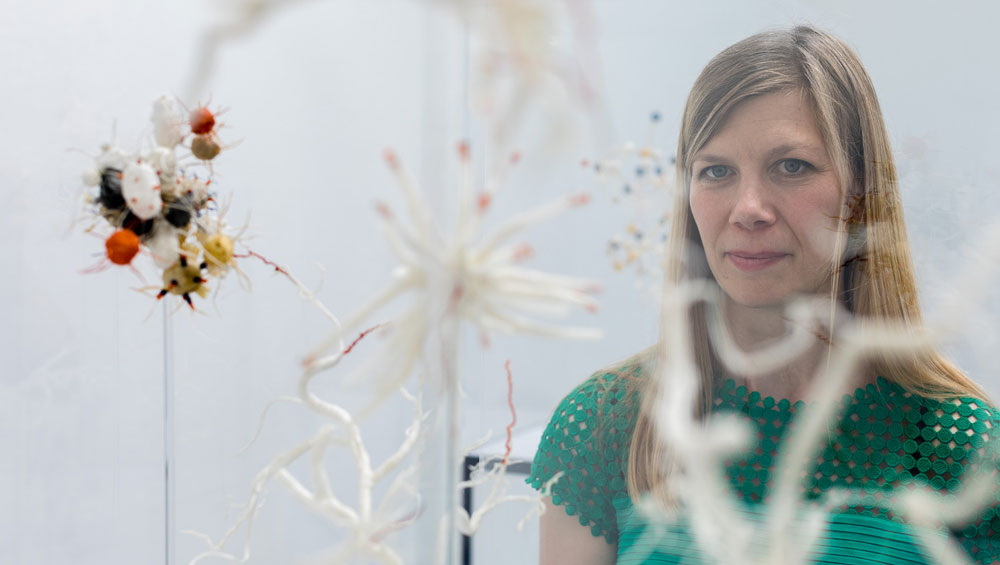
by ANNA McNAY
One of five artists participating in the sixth edition of the Jerwood Makers Open, Laura Youngson Coll (b1978) trained in fine art and sculpture, but went on to work at a bookbinders, learning intricate leatherwork techniques that now define her sculptural installations, which are made primarily from vellum. Her studio in Crystal Palace, south London, is based within the bookbinders’ space, down a cobbled side alley, and she still works for them alongside her own practice, collecting scrap materials, which she transforms into her astoundingly beautiful works of art. Her Jerwood commission, which comprises three vitrines, each containing three pieces, responds to the personal tragedy of losing her partner, Richard, to non-Hodgkin lymphoma in 2015. A mixture of fact and fiction, her depictions of tumours and chemotherapy drugs, mutated cells and antigens are at once alluring and repellent, beautiful and abject. Having fought lymphoma myself as a teenager, I was intrigued to meet with Youngson Coll to find out more about her work and her and Richard’s story.
Anna McNay: To get an idea of your work now, we should start at the beginning and look at how you ended up working with vellum and having this studio space in a bookbinders. You studied sculpture at the Royal College of Art. What was it that led you down this route?
Laura Youngson Coll: Well, I trained as a sculptor, and I did my degree in Dundee, and my MA at the Royal College. With my sculpture, I would always start by thinking of an idea, and then I’d find the materials to realise that idea. I used a lot of plant materials as well as more traditional sculpting materials – a bit of whatever, really. My work has always been very intricate and about exploring materials in an intricate sort of way. When I was doing my MA, by chance, I started working for a bookbinder. They make one-off bespoke books, but also a lot of interior stuff, furniture and wall panels. We use traditional leatherworking and bookbinding techniques, so it’s great in that respect, because it’s keeping those skills alive.
I was a little burnt out when I finished my MA, so I ended up moving away from my own practice a bit, and started working more for the bookbinders, learning skills, such as paring and starch-paste gluing – skills that I now use in my own sculptural work.
AMc: Can you explain what paring is, in lay terms?
LYC: Paring is when you use a surgical scalpel to thin the leather or vellum. It’s traditionally used as a joining technique, so you can get a seamless join. You would have a piece of material and you would pare the very edge, so it’s absolutely wafer thin, and then it graduates into the whole thickness of the material. I’m using that technique a lot now in my sculptural work because, especially with vellum, it reveals a real translucency in the material. I’m interested in that. I’m trying to pare bigger areas just to get that translucency.
AMc: Is vellum the same as leather?
LYC: It’s not, no, and I’m using it more and more. The piece for the Jerwood Makers Open is almost exclusively vellum. It’s a fascinating material. It’s calfskin, the vellum that we use here, but it’s not tanned in the same way as leather. It’s stretched and scraped and stretched and scraped and so it’s not a chemical process as such, although I’m sure there are chemicals involved somewhere along the way. But it’s not like tanning. You can probably best imagine it by thinking of parchment. It’s like thick paper and, in fact, they used to make illuminated manuscripts with vellum.
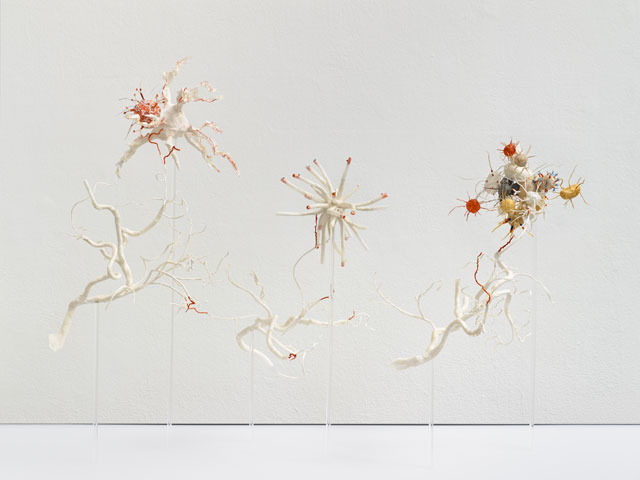
Laura Youngson Coll. Angiogenesis, 2017. Vellum, Supernatural vellum, dyed vellum. Photograph: Anna Arca.
AMc: Yes, of course.
LYC: It’s a very fine material, and I enjoy playing with that. My work is not what people would expect of a leather sculpture because it is so fine and delicate. A lot of that is down to using vellum, or to using very small scraps. Then you get the hair follicles in the material as well, which is really interesting, and they become even more prominent when you pare it.
AMc: Your works must be really delicate, then? They look as if they would crush easily.
LYC: Not really. The technique that I use is another technique that I learned from the traditional bookbinding – starch-paste gluing. I cast my vellum around a shape, or manipulate it while glued, and it dries into a sculptural form. The starch-based glue makes it quite robust. And vellum itself is a very robust material. People look at my work and think, “Oh, goodness, it’s so fragile”, but actually it’s not.
,-2017-3.jpg)
Laura Youngson Coll. Angiogenesis, 2017 (detail). Vellum, Supernatural vellum, dyed vellum. Photograph: Anna Arca.
AMc: It must be fiddly though?
LYC: Yes, that’s what I like about it.
AMc: You completed 10,000 hours of this “quasi-apprenticeship”, synonymous with skilled craft practice.
LYC: Yes, I think over the years I’ve probably clocked up around that. It’s quite laborious work, but it’s good thinking time. Especially once you get good at it, your mind can wander. I quite enjoy that aspect of it. But you do have to put the hours in. When I first started paring, I thought I would never be able to master it, especially with vellum.
I got to the point where I’d been doing this for a while and was getting frustrated. It can be creative, but the majority of the work is technical. That was around 2012 or 2013, and I realised I had to start making my own work again. I thought: “I have learned all these extraordinary skills, why not start with the material and then work from there?” And that has worked really well. I don’t find it restrictive because I still think there’s a lot of experimentation within those materials. It gives me freedom rather than restriction to know that I’m going to be using those materials to realise what I want to make.
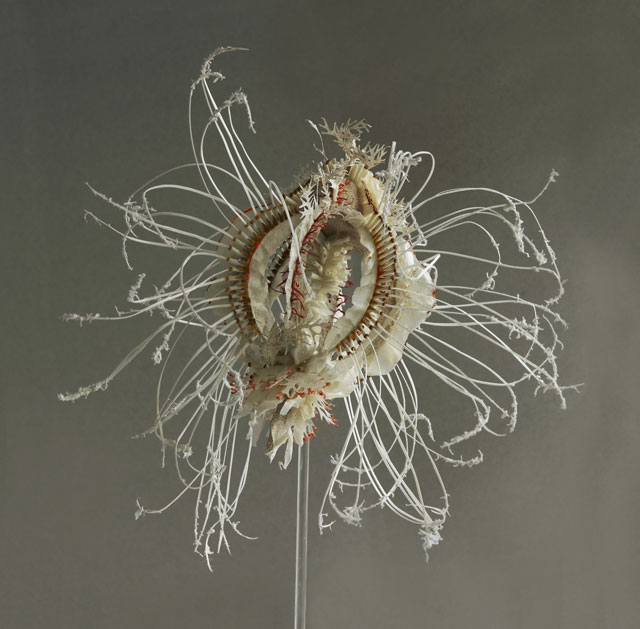
Laura Youngson Coll. Haeckel I, 2015. Vellum, Supernatural vellum, hair, sheep leather, armature, approx. 25 cm in diameter. Photograph: Laura Youngson Coll.
AMc: Have the themes of your work always centred on the world of nature and natural sciences?
LYC: Yes, my work has always been about the natural world and our relationship with it. Often, we seem to place ourselves in opposition; as a separate entity outside of the rest of the natural world, experiencing it through the intermediary of cultural and scientific constructs. My piece about lichens, Indicator Species (2014) [for which she won the Perrier-Jouët Arts Salon Award 2014], for example, is a small examination of this. Some of them thrive in really toxic environments, and some of them will only thrive in very clean environments. It’s very subtle: the different lichens that will grow, that are acclimatised to different environments. You can tell a lot about an environment by the lichens that are there. I like that idea that this small, overlooked, and probably most people would think insignificant, kind of thing is actually a huge indicator of the wider environment. Similarly, the microscopic world is a fundamental yet relatively unfamiliar one: we directly experience it as it quietly sustains us and all living systems, but our visual perception of this world is limited. This is what led me to start work on the Haeckel pieces, which are going to be shown as part of The Woman’s Hour Craft Prize this autumn. Ernst Haeckel was a 19th-century biologist, who looked through a microscope and drew all these previously unexamined, microscopic organisms. With the Jerwood work, I’ve gone even further from that into the cellular, and even the molecular. I’m really interested in exploring these unseen worlds. I’m fascinated by how they can be imagined, and how I can choose to depict them.
,-2014.jpg)
Laura Youngson Coll. Haeckel I, 2015 (detail). Vellum, Supernatural vellum, hair, sheep leather, armature, approximately 25 cm diameter. Photograph: Laura Youngson Coll.
AMc: How do you source the information and the knowledge to recreate them? Do you work from images in books?
LYC: A big part of my work has always been that some of it is fact and some of it is fiction – and some of it is a mixture of both. The Haeckel pieces are based on his drawings, but I haven’t copied what he’s drawn, so they’re not an existing creature. I like the fact that, although a lot of these things are fictitious, they could be factual. A lot of my work appears very intricate and beautiful, but some of what it represents, especially with the Jerwood piece, is quite macabre. There’s a fine line there.
AMc: Absolutely. When you see the Jerwood piece, it draws you in, because it does look beautiful from a distance, but then, when you get closer, it is a little bit abject, or there is something about it that looks not quite right. And, of course, this is absolutely the case because the piece came about in response to the personal trauma of losing your partner, Richard, to non-Hodgkin lymphoma.
LYC: Yes, and it was a big departure in my work, because although, before, I’d always made work about subjects that were very important to me, I’d never made work about my personal life as such. When I put in the proposal for the Jerwood Makers Open, I did think carefully about it, because I realised the implications, but I remember being quite shocked when I got it and realised I had to go into quite a public sphere and explore those ideas. The making of this work was difficult, going to the haematologist and finding out all the biological detail. You think it will make you feel better if you know everything there is to know, but while I found it fascinating on a purely objective level – I love biology, as you know – I don’t think there was any catharsis in it. The real catharsis was in the making process, because that’s something that’s personal to me, and it’s the way in which I assimilate things. The whole work was about the attempted reconciliation between the microscopic, the scientific, and the emotional experience of what is actually happening to someone.
AMc: Did you already have the idea to make this work while Richard was still fighting the lymphoma?
LYC: No, it was afterwards. The first piece in the Pathogenesis series is quite spiky and very intricate and I started making it just after Richard died. It was a very emotive, immediate reaction to what had happened, and I wasn’t sure whether I was going to include that piece in the Jerwood, but I thought it was a really good start to the narrative of the piece. Because it did turn into a very narrative piece.
AMc: Is Pathogenesis purely imagined, then?
LYC: Yes, that piece is not scientific at all. There are three pieces within it. They don’t have individual names. The first of the three was intended as an imagined biological depiction of a B-cell, which was the main cell involved in Richard’s lymphoma. The second piece is a more organic, but not entirely accurate, depiction of a B-cell – I am starting to move towards true biology. The third piece in the series, with the feathers, has orange Y-shaped components on the surface, which are antigens. That’s a very graphic symbolism of a B-cell, as they always have antigens on the surface. The feathers – which are incidentally not real feathers, they are also made of vellum – came about because I found out that birds have a special organ that produces B-cells or white blood cells. Early investigation into the immune system was furthered by investigation into this organ in birds. It is called the bursa of Fabricius, so that’s where the B-cell name comes from. On top of that, there were also some personal bird references between Richard and me. Throughout the piece there are these scientific narratives, but also personal narratives.
The second piece, Angiogenesis, has a more scientific narrative running through it. Angiogenesis is the process of a tumour creating its own blood vessels so that it can survive and grow – which I think is pretty horrific. It has strong symbolism. The piece depicts blood vessels going into the cells and turning red, so it’s very visual and quite dynamic. The first one is a dendritic cell presenting a pathogen to a B-cell. You probably know a lot about the science of this already, don’t you?
AMc: No, not really. As you know, I had Hodgkin’s lymphoma a couple of times when I was younger, but it is 20 years ago now, so my science is a little bit rusty.
LYC: OK, I just didn’t want to go over ground that you already knew. Usually, the dendritic cell introduces a pathogen to the B-cell, and then the B-cell generates antibodies to fight that pathogen or virus. The DNA of the cell is completely rearranged in order to produce those antibodies, so it’s very vulnerable at that point, and that’s the point where a mutation can take place, and the cancer can start. So this piece is representative of the beginnings of it all. The second piece in this vitrine is constructed of chromosome-like shapes in a spherical form and is about a particular diagnostic technique used to identify aspects of DLBCL (non-Hodgkin diffuse large B-cell lymphoma). In c-MYC-positive lymphoma, the c-MYC gene translocates from the correct chromosome to another chromosome, creating mutation and genetic instability within the cell. This is also significant because the c-MYC gene translocation was a complexity of Richard’s disease, which made it particularly difficult to treat.
The third piece in that vitrine is a tumour and, shockingly, it is quite accurate in size – Richard’s tumour was about 10 x 12 x 8cm. They removed it after four different courses of chemo hadn’t worked. I think they knew the surgery wouldn’t work either, but it was one last attempt. Because lymphoma is a blood cancer, they don’t usually use surgery. The surgeon sent him a picture of the tumour. It’s this horrible, extraordinarily visceral thing. This piece is a cellular, rather than visceral, depiction of immature or mutated cells, which create a tumour. Examining things on a cellular level can move us away from the visceral; the unfamiliar nature of these cellular structures can create a distance from the emotive and the bodily. This is deliberate within the work, and exaggerated by the isolated artifice and beauty of the pieces. I wanted to convey the compartmentalising that is often necessary to cope with watching someone succumb to disease, and the contradiction of the hope and inadequacy of scientific explanation in the face of emotional and physical pain. The work shows cells presenting themselves in immature or mutated ways, and the antigens on the surface presenting in different ways. I used colour to reference the microscopic dyes that are used to highlight things when you photograph cells.
AMc: How long was it from Richard’s diagnosis to this point at which he was given surgery?
LYC: He was diagnosed at the beginning of August 2014, and then the first course of chemo went on until Christmas. Initial prognosis was good; we were given an 80% chance of cure. Although it is an aggressive form of cancer, it can often be treated very effectively with chemotherapy, especially if you are otherwise young and fit, as Richard was. However, post-treatment scans revealed in January 2015 that it hadn’t entirely worked. At this point, everything became much more uncertain – no prognosis beyond the warning that refractory disease complicates the outcome. At that point, the aim was to continue different chemotherapy treatments in order to get him into enough remission to give him a stem-cell transplant. They tried three different courses, but it was simply too aggressive.
AMc: Were you proactive about finding out scientific detail at the time?
LYC: I was. Richard didn’t want to know very much. I know people cope with things in different ways and some people want to know absolutely everything, while others just don’t want to know anything. He was incredibly determined. He wanted every treatment he could have, but he didn’t necessarily want to know the scientific detail of it all. I did a little bit of reading, but it was such a crazy time. There were so many practicalities to consider that, quite apart from anything, I don’t think I really had time to investigate further than what the consultant told us, and the few pamphlets I read. Our daughter was also very young, so it was crazy. Richard died in June 2015, and I started the Jerwood piece – apart from the first Pathogenesis – a year later, so I guess the consultant I spoke to then could be quite candid with me.
AMc: The way your works are presented seems to be incredibly important as well. In the Jerwood installation, they are well lit within glass vitrines. It gives them a clinical feeling, a sense of keeping the visitor on the outside.
LYC: Yes, it’s crucial how the work is presented and how it’s lit. I think the cases are successful, because they’re quite slick and the detail of the work needs that. It needs them to be as discrete as possible. They have quite a scientific feel. There is also something about isolating biotic systems in order to understand them, a very scientific approach, which I find fascinating in its artifice.
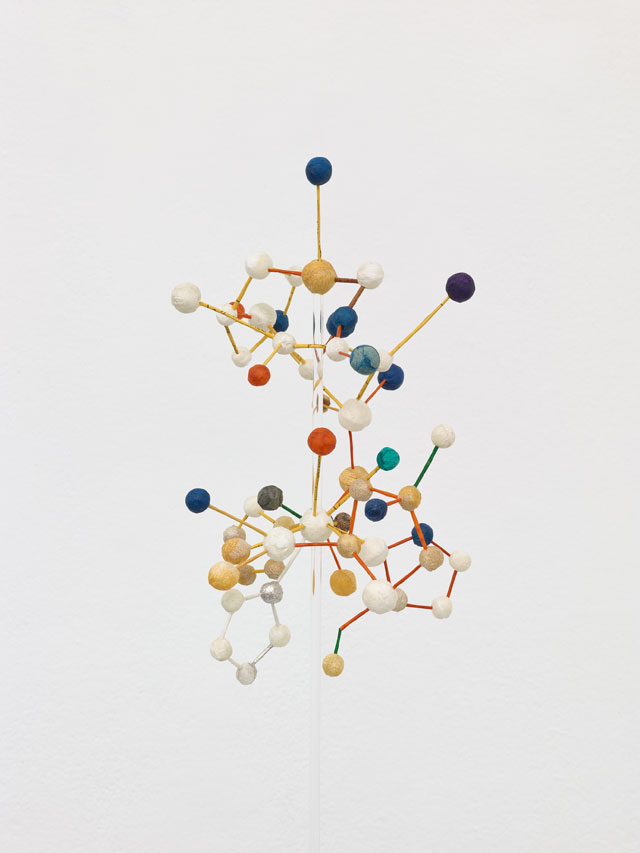
Laura Youngson Coll. Regimen, 2017. Vellum, dyed vellum, Supernatural vellum, medical card, birch bark, platinum leaf. Photograph: Anna Arca.
The third piece, Regimen, depicts a molecular structure, but it isn’t a scientific depiction of any particular drug – it was about all the different drugs that are involved. I integrated into that a medical card that Richard was given – it’s just a list of all the medications, what they do, what the side-effects might be. You can see bits of writing if you look closely. This piece is all about the fact that there are the drugs, and then the drugs to counter those drugs, and so on. You probably know.
AMc: I remember swallowing about 50 pills a day, and some were the size of suppositories.
LYC: It was awful watching it. I can’t imagine actually having to go through it. I’m so glad to hear that you made it through and made a full recovery.
For this final piece, I used platinum leaf on one of the structures, because one of the chemotherapy drugs had a platinum component, and one of the stalks is made from birch bark, which again is a personal reference. It’s just meant to represent this confusion of molecules, because I think it does feel like that – hugely complex and confusing.
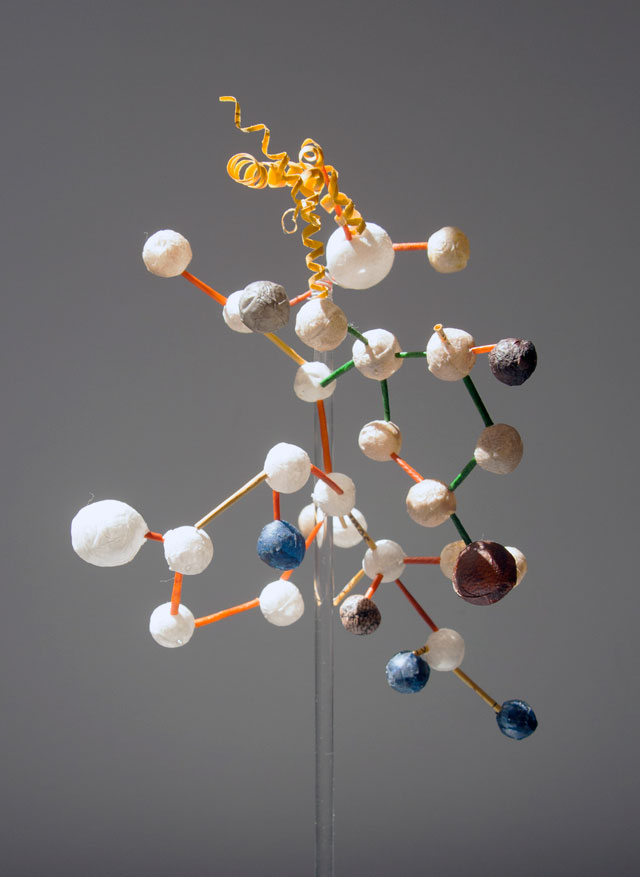
Laura Youngson Coll. Regimen (work in progress), 2017. Vellum, dyed vellum, Supernatural vellum, medical card, birch bark, platinum leaf. Photograph: Laura Youngson Coll.
AMc: This final piece is somehow less threatening than the previous ones, however.
LYC: Yes, and it was quite interesting to move into the more graphic, as the other pieces are very organic. I like the contrast.
AMc: Has the haematologist, or anybody else you consulted with, seen the finished works?
LYC: Alasdair Rankin, the director of research at Bloodwise, the UK’s specialist blood cancer charity, came to the opening. I had a long discussion with him about my work, which was great. The consultant wasn’t able to make it, but I’m hoping at some point we can meet up and I can explain the work to him. I’m sending him a catalogue, so at least he’ll see images of it. He was so helpful. Before I saw him, I was looking at medical papers, and the terminology was just beyond me. Conversely, other information I was finding was much too general – it wasn’t specific enough for Richard’s case. Alasdair is keen to put some of my work on the Bloodwise website and maybe to interview me, explaining the piece for their promotional work, which is great, because I want to give something back. It’s another way of looking at it, isn’t it? And some people might gain something from that. The work has triggered quite a lot of personal conversations with people saying: “Oh, I’ve experienced this, it’s similar.” It’s interesting what it brings up.
AMc: Is this work now complete, or do you still have further pieces to add?
LYC: There’s one piece I was thinking about, based on something the consultant described to me – a cutting-edge technology in treating lymphoma, where they take cells out of the body and genetically engineer them so that they will kill the cancer cells, and then they reintroduce them back into the body. It seems extraordinary. They’re doing trials on this at the moment. People get very ill, because the immune system goes into overdrive, but they don’t generally die. And, of course, your cells are not being poisoned like in chemotherapy.
I’d initially proposed to make a piece about how future technologies might develop, but it didn’t quite seem appropriate for the Jerwood work, because that wasn’t the outcome – it wasn’t what happened with Richard. When you hear about these developments, it’s a very mixed reaction. Obviously, you’re very pleased that these advances are being made, but, on the other hand, you are like: “It’s too late!” But I’d be quite interested to follow on from those pieces. This is the next thing I’ll explore, I think. The visual imagery from this advance is pretty strong for me.
AMc: Obviously in the Jerwood work you were primarily driven by the story, but what role did the visual imagery play for you?
LYC: I was wary of that at the beginning because cellular, microscopic images are so extraordinary. It would be easy just to reproduce those, but I wanted to examine them a bit further. I think that is why it’s important that a lot of personal narratives run through the work, or that there are a lot of different narratives on different levels – I’m not just purely making scientific depictions. My imagination is apparent as well. And, actually, the material dictates a lot. A lot of it is just about experimenting with the material and the possibilities that opens up. I always have something in my mind’s eye, but it never turns out exactly how I expect. And I wouldn’t want it to. I don’t want to just translate what’s in my mind and turn it into three dimensions. The anthropologist Tim Ingold said something in his work on creativity that struck a chord. He was talking about material process and makers and said: “The properties of a material are not objectively measured, nor subjectively attributed, but practically experienced.” It’s not about imposing form on to matter, it’s about finding the grain or the bend of the grain and evolving that material into what you want to make.
AMc: You have exhibited a lot in craft-related fairs and exhibitions. Do you consider your work to be a craft? Where is the line drawn between art and craft? Do you feel that something designated as craft is given less value than something designated as art?
LYC: I trained as a fine artist and it’s always frustrated me that if things are beautifully made, they are considered conceptually weak. I never thought that was the case. I thought you could have both, and it surprises me that my work has been shown primarily in the craft arena. Well, it’s not surprising because it’s so materially based now, but I hope to produce something materially based that is conceptually interesting as well. Over the past few years, there has been a category developing within craft of conceptual artwork. That’s really interesting and exciting.
AMc: So maybe craft is starting to be valued more? There’s certainly more demand for it now in the kickback against everything having turned so conceptual.
LYC: I remember it being almost a dirty word. Before, I would maybe have been horrified if you’d described my work as craft, but now I don’t mind. It’s all about the material. I mean, material is conceptually interesting because it dictates what you’re making to some extent. It transforms what you’re making, or transforms your ideas. It’s all intertwined.
• Jerwood Makers Open 2017 runs until 27 August at Jerwood Space, London, before touring to New Brewery Arts, Cirencester, Glocuestershire, 15 September – 5 November; Devon Guild of Craftsmen, Devon, 20 January – 11 March 2018; and Pier Arts Centre, Orkney, from 24 March – 9 June 2018.
• Laura Youngson Coll will also be showing work in The Woman’s Hour Craft Prize at the Victoria & Albert Museum, London, from 7 September 2017 – 5 February 2018, before touring to venues around the UK.